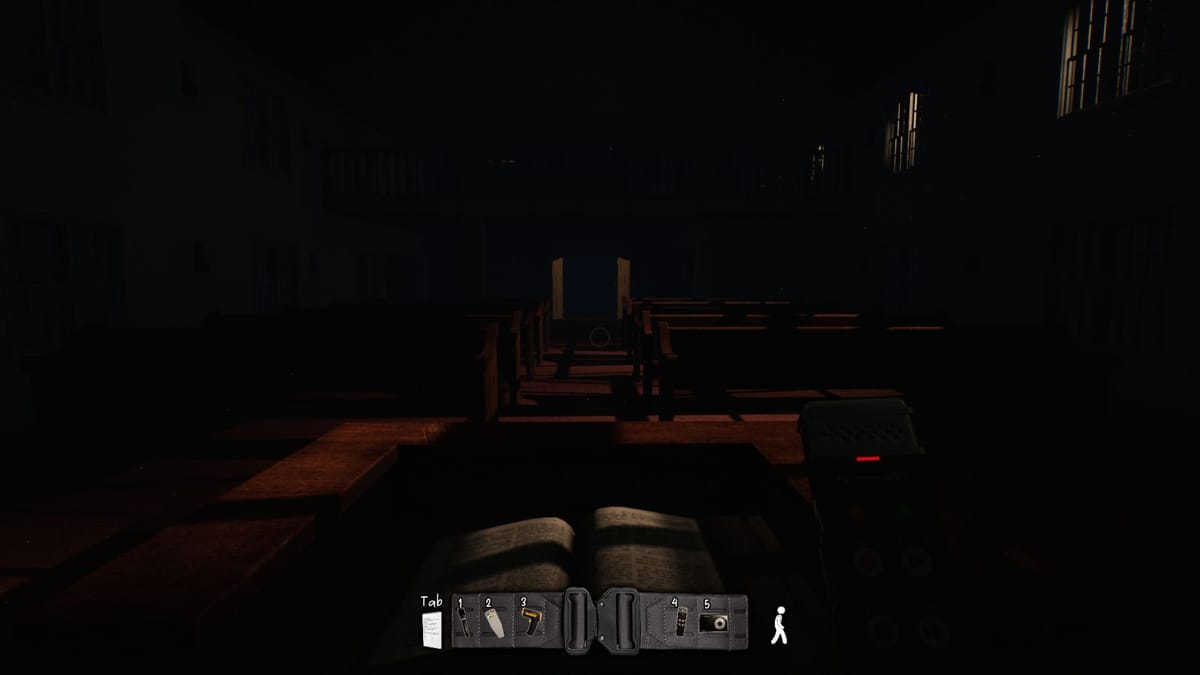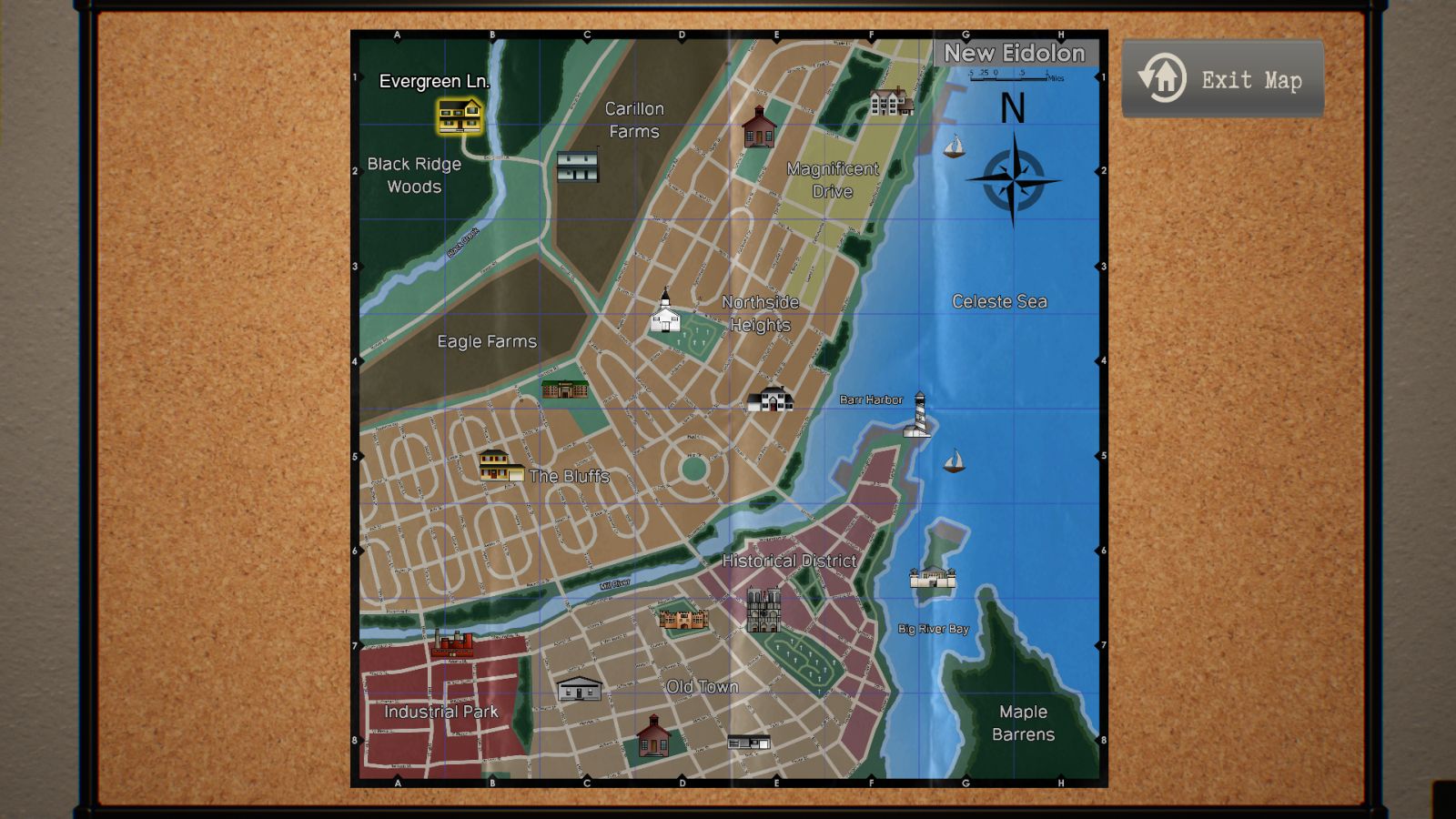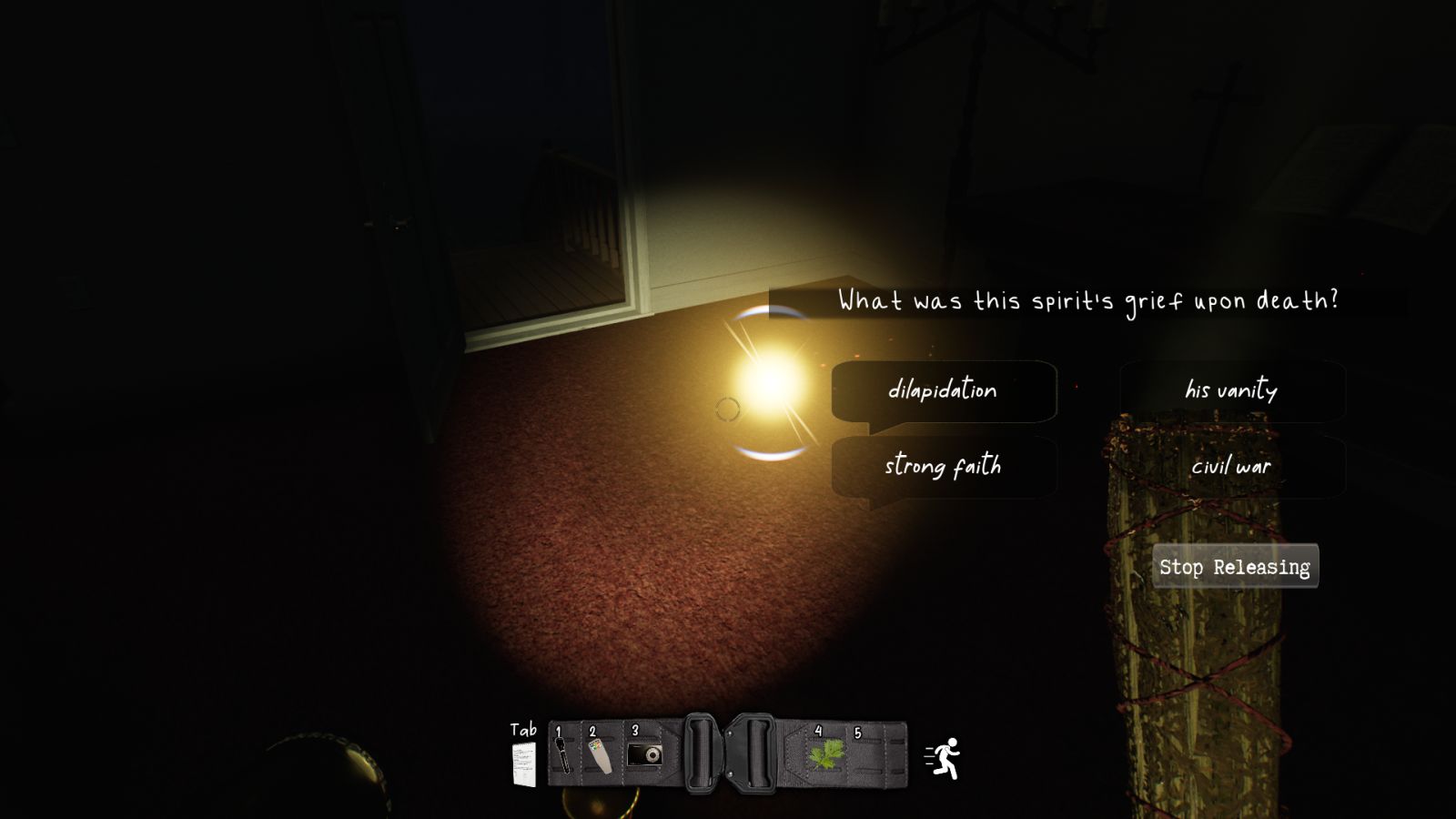
How long does a horror game remain scary? Twenty matches? Ten? I remember the first time I played Phasmaphobia, and frankly, I was terrified. When the ghost hissed in my ear, I almost jumped out of my chair. However, many successful hunts later, the edge is almost completely gone. It’s purely analytical; get in, evaluate the evidence, and the ghost is as good as caught. This isn’t a slight on the game either, it’s only natural as the fear of the unknown wears away. Phasmaphobia’s popularity spawned a deluge of ghost-hunting games. Enter Conrad Stevenson’s Paranormal P.I., a slow-paced, single-player, ghost-hunting game that honors the real-life inspirations for the genre, for better and for worse.
Conrad Stevenson’s Paranormal P.I. is the debut game of D&A Studios. First and foremost, this is not just a paranormal investigation game, it’s a paranormal investigation simulation. Every investigation starts in Conrad’s office, which doubles as a paranormal activity museum. The broader setting is New Eidolon, seemingly a facsimile of Boston, Massachusetts, or the New England area in general. The word Eidolon refers to an ancient Greek phantom or ghost, fitting the theme.

You don’t just jump right into an investigation, there are steps to ghost hunting. This game is SLOW. You’re not hunting the ghost as you would in Phasmaphobia, you’re unraveling its story piece by piece, racking up the evidence, and doing research online. In all likelihood, you’ll have to return to a location many times over in order to identify and pacify every ghost, demon, and entity. The actual process of doing so ranges from startling, suspenseful, and intriguing, to mind-numbingly boring.
As stated, the investigation doesn’t start on location, it starts with a simple email from those requesting your services. Specific grievances in the email are highlighted, such as seeing shadows moving, items thrown about, and odd noises. Clicking on the highlighted text adds them to your notebook for when you visit the site. You can only have six notes at a time, so you have to choose wisely. There’s also the archives and wiki to comb through.
Upon visiting a location, you find scraps of evidence littered about the place. This evidence is added to your archive to give you a better picture of what you’re dealing with. The email might have told you that there are shadows near the barn, but archive evidence will tell you that there were bodies found in a hay bale in 1945 or give you a photo that helps fill in the blanks. Archive info can be added to notes, meaning the investigation evolves over time. Finally, the wiki provides information on specific types of spirits, demons, and select locations. In addition, the wiki has tutorials for just about every device and mechanic in the game, which is helpful given how complicated the game can be for beginners.

The way the preparation phase is presented is practical and realistic. For example, let’s say you want to look up a location on the wiki. Well, you’re limited in your information. There’s not going to be any information on private residences, but you’ll find a ton of information for the local church grounds or lighthouse. Going through archives, emails, and the wiki to compile evidence is surprisingly engaging. Puzzling together which information relates to which entity and uncovering their backstories turns what could have been monotony into intrigue. In addition, taking notes on a ghost will cause it to act up more, thus giving you a better shot at finding something paranormal.
Mind you, much of this is before you even step foot onto the property. The first level, Evergreen Lane, serves as the tutorial. It’s here that you get acquainted with the tools of the trade. A flashlight, an EMF meter, a thermometer, a camera for taking pictures of the ghost when it manifests, and an audio recorder to capture its vocalizations are all tools you will utilize while investigating. These are the core gear, and most upgrades will be some variation for them. Even using these simple devices has depth. Ghosts prefer the lights off, so the flashlight grants you much-needed illumination. The EMF will activate when near a spirit or electronic devices, so it might be paranormal or it might be that sick OLED T.V. in the corner.
However, there are some misfires. You get a voice line whenever you scan for temps or use EMF, and they’ll confirm or deny whether it’s paranormal or not. This leads to some funny moments like Conrad noting that the readings are so cold that they MUST be paranormal… in a basement… with air conditioning. Gathering temps and EMF data can be finicky. When you’re in the right spot to gather information, a progress meter will fill, but at times it can feel like a pixel hunt. The meter will go from filling, to gone, to filling again, then disappear entirely. It’s frustrating, especially when it feels like most of the readings are declared natural causes, meaning it wasn’t disappearing because the ghost was moving, but because it was bugging out. Since ghosts move about the place unseen, you have to wrangle a moving invisible entity like you’re playing Battleship, shooting in the dark. Once again, frustrating.

While moving around the Evergreen Lane house, Conrad will chime in about what you need to do, saying something like, “I thought I did this in the dark.” or, “I should turn off that light.” That’s all well and good, but I’m inclined to disagree with Mr. Stevenson when I hear raspy breathing emanating from… somewhere. My hesitancy to turn off the lights is an ode to the quality of the subtle horror. While you can turn on jump scares, most of the time ghosts will just appear, and you’re left in shock as they walk by or approach you.
After you’ve gained EMF readings, temperature data, and some archive notes, you’ll want to find a few audio recordings and a single picture of the ghost, thus filling another progress meter. In a nice touch, gaining more evidence fills out your notepad, so you don’t need to go into a menu, thus maintaining the immersion. Once you’re done with all that, the investigation is pretty much concluded. You go back to the office, contemplate which spirit you’re facing, grab the right type of incense to smudge them, and then return to the property.
Finally, you’re at the cleansing portion of the investigation. You’re going to be looking for an object that the entity has attached itself to, and smudge the location with incense. The smudge will burn when you’re in the right spot. You’ll place the ghost attachment item down and begin the ghost therapy session. The spirit will manifest, and you have to follow it around and talk to it. Every time you interact with it, four possible answers will come up relating to its life and death. Maybe the ghost had a child who died of illness and they blame themselves. You have to let them know it’s not their fault so they can move on to the afterlife. I hope you did your homework because if you fail any of the questions, you have to start the ritual over again. It’s always pleasant helping a ghost find closure in this world and helping them move on to the afterlife.

At the end of the day, completing an investigation is narratively rewarding. The fact that you spend so much time on each case leads to more intimate investigations and resolutions. That’s something you can’t really get in Phasmaphobia with its generated ghosts. Given how complicated the game can feel, I wouldn’t blame players for using a guide, but I do think they would be cheating themselves out of some stellar story beats.
Paranormal P.I. has its frightening moments, but it also undermines itself with conflicting game design. Under no circumstances can Conrad be seriously harmed, and he knows it, you can hear it in his tone. Walking through a heavily wooded area where a murderous cult resides? Conrad is not phased. Going to a lighthouse where it’s rumored that couples go missing? Conrad fears no god. At one point, I got mauled by a Wendigo just to have him get up and quip, “Worst game of tag ever.” I didn’t even try to run from it.
Well, it’s not really a run anyway, the sprint option is called “hustle,” which I would call an apt descriptor. It’s less of a method of escape and more of a “nope” walk; the kind of motion you observe people do when they see a scary bug in the room they just entered. It’s not like there’s any real reason to run though. The worst that happens is your batteries drain and you need to go back to the truck for some more. It was at that point that I suspected there was something paranormal about Conrad himself, although this was never confirmed, it remains my head canon.

Conrad’s lines are consistently monotone, and the most emotion you’ll hear out of him is when he geeks out over how extraordinary a piece of evidence is. Is he In the middle of a cleansing ritual and confronting a spirit on its lingering guilt? Doesn’t matter, he speaks with the tone of a guidance counselor telling little Timmy why it’s bad to curse. I’ve got to say, I really don’t mind it. I always find it off-putting when the character who’s supposed to be a player vessel displays emotions I don’t. Also, it’s just plain funny to imagine Conrad walking through a haunted graveyard with his notebook, completely unphased as paranormal activity happens all around him.
The lack of any real stakes undermines the horror, but I can see why it was designed this way. Given how long every investigation takes, it would be a real pain to lose your hard-earned progress or even restart. It would also be jarring to hear Conrad constantly screaming at every apparition. Overall, it would take away from the simulation aspect of the game if you were constantly scared of dying. In the end, it had to be this way.
That brings me to my final point. By far the biggest way the game shoots itself in the foot is the waiting. Remember, you’re a ghost therapist. You can ask questions, bring your notes to the session, and make the spirit feel comfortable, but at the end of the day, the ghost will decide when it talks. You might even be waiting for minutes on end for the apparition to appear to snag that vital photograph that you need to progress. God forbid you miss it.

While the slower pace sets Paranormal P.I. apart, it also hinders it. The developer replied to one player’s criticism of the pacing on a Steam discussion saying, “This is a waiting game and no matter the dressing I put on it the bones of the code are written around the player needing to respond when the ghost performs an action timely.” He also said, “I have several thoughts on this, but I don’t think I can adjust it for this game without overhauling the entire game. At this point, that is not a reasonable option. I think the best thing to do is finish this game and remember the lessons learned and make my next game better.” However, the developer stands by the Paranormal P.I., citing its largely positive Steam reviews and low price point for how many hours of content you get. I agree with him on all of these points, but that doesn’t change the fact that slow investigations with no stakes lead to a rather flat horror crescendo. Yet, that doesn’t take away from the horror imbued by the stellar atmosphere. It’s a game that allows the player to be a paranormal investigator, thus succeeding in what it set out to do, even if it can be tedious at times.
Overall, Conrad Stevenson’s Paranormal P.I. offers a true-to-life ghost-hunting experience, both in the sense that you’ll be terrified, and that you’ll be standing around for long periods of time questioning your sanity. Paranormal P.I. really shines when you’re clicking through the archive, making connections, unraveling the stories of the ghosts and dark locales, and witnessing a specter creep by. You can feel the dev’s passion for the paranormal in every part of the investigation process, and that infectious passion leaves an impact on players.
Conrad Stevenson's Paranormal P.I.
Good
Conrad Stevenson’s Paranormal P.I. immerses players in New Eidolon’s numerous haunted locations and history. Although hunting ghosts can be tedious, the game always excels with its ghost stories and they always finish in a satisfying manner. However, if you just glanced at the Steam page and thought it looked like Phasmaphobia, then you’re going in with the wrong expectation. It’ll be like expecting milk and getting orange juice.
Pros
- Faithful to real-life ghost-hunting, intriguing
- Immersive atmosphere
- New Eidolon has lots of lore to uncover
Cons
- Faithful to real-life ghost-hunting, lots of waiting
- No stakes lead to less tension
